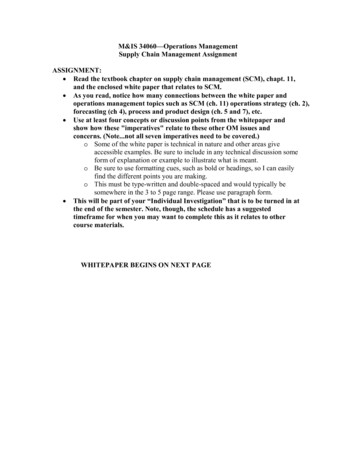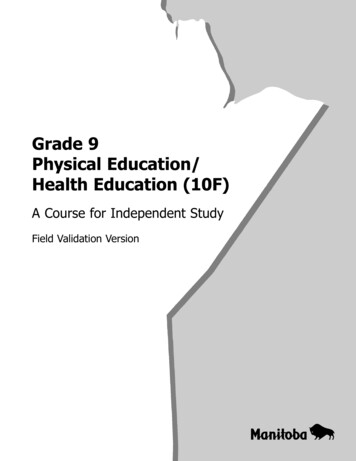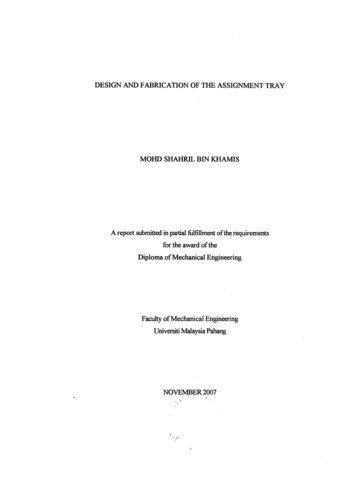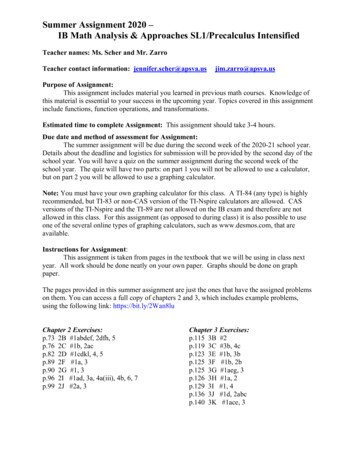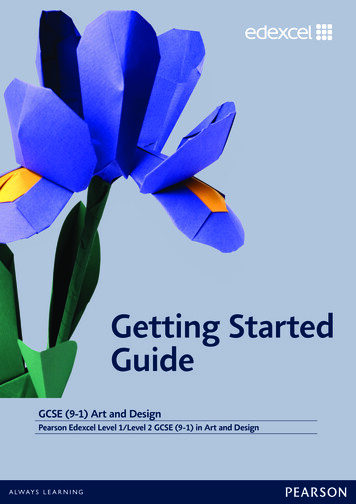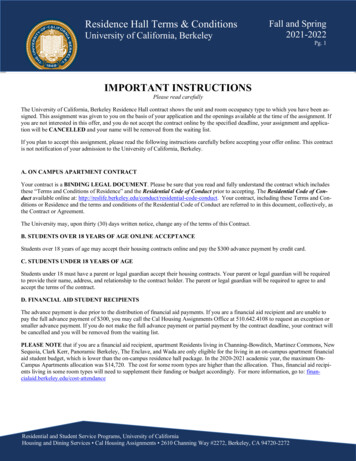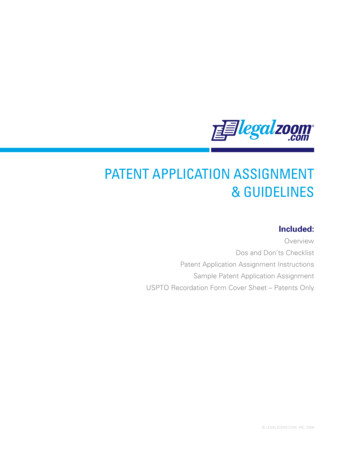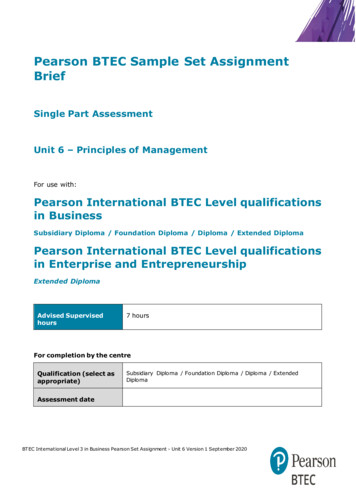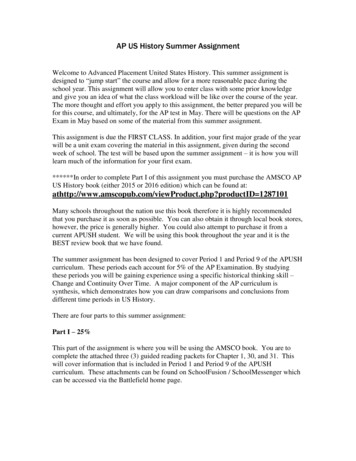
Transcription
AP US History Summer AssignmentWelcome to Advanced Placement United States History. This summer assignment isdesigned to “jump start” the course and allow for a more reasonable pace during theschool year. This assignment will allow you to enter class with some prior knowledgeand give you an idea of what the class workload will be like over the course of the year.The more thought and effort you apply to this assignment, the better prepared you will befor this course, and ultimately, for the AP test in May. There will be questions on the APExam in May based on some of the material from this summer assignment.This assignment is due the FIRST CLASS. In addition, your first major grade of the yearwill be a unit exam covering the material in this assignment, given during the secondweek of school. The test will be based upon the summer assignment – it is how you willlearn much of the information for your first exam.******In order to complete Part I of this assignment you must purchase the AMSCO APUS History book (either 2015 or 2016 edition) which can be found ctID 1287101Many schools throughout the nation use this book therefore it is highly recommendedthat you purchase it as soon as possible. You can also obtain it through local book stores,however, the price is generally higher. You could also attempt to purchase it from acurrent APUSH student. We will be using this book throughout the year and it is theBEST review book that we have found.The summer assignment has been designed to cover Period 1 and Period 9 of the APUSHcurriculum. These periods each account for 5% of the AP Examination. By studyingthese periods you will be gaining experience using a specific historical thinking skill –Change and Continuity Over Time. A major component of the AP curriculum issynthesis, which demonstrates how you can draw comparisons and conclusions fromdifferent time periods in US History.There are four parts to this summer assignment:Part I – 25%This part of the assignment is where you will be using the AMSCO book. You are tocomplete the attached three (3) guided reading packets for Chapter 1, 30, and 31. Thiswill cover information that is included in Period 1 and Period 9 of the APUSHcurriculum. These attachments can be found on SchoolFusion / SchoolMessenger whichcan be accessed via the Battlefield home page.
Part II – 25%This part of the assignment will introduce you to on line video review material providedby the Gilder Lehrman Institute – www.gilderlehrman.org. You should register as astudent on this site, all material provided is free.Watch the videos for Period 1 and Period 9. Take notes using the attached outlines,which are the College Board provided outlines for these periods.Part III – 25%This part of the assignment will introduce you to the type of ancillary reading materialyou will be required to read in AP US History. This reading will cover Period 1 materialand you should annotate this essay are you read it. Answer the questions at the end of thereading. The reading is called Myths That Hide the American Indian and is posted onfusion/school messenger. You may access this via the Battlefield home page.Part IV – 25%This part of the assignment will introduce you to APUSH vocabulary. For Period 1 andPeriod 9 complete the required vocabulary on 3”x 5” index cards. You will becompleting the vocabulary at the end of Chapter 1, 30, and 31 in AMSCO. The termshould be on the front of the card with a definition and historical significance on theback. The historical significance addresses why this particular term is relevant – why is itimportant to this historical period study?If you have any questions during the summer you can reach us at the following emailaddressesMr. Fronckel – fronckmc@pwcs.eduMrs. Maiuri - maiurikl@pwcs.edu
THIS NOTE SECTION GOES WITH AMSCO CHAPTER 1Name:Guided Reading & Analysis: A New WorldChapter 1- A New World of Many Cultures, 1491-1607, pp 1-13Purpose:This guide is not only a place to record notes as you read, but also to provide a place and structure forreflections and analysis using your noggin (thinking skills) with new knowledge gained from thereading. This guide, if completed in its entirety BOP (Beginning of Period) by the due date, can beused on the first quiz as well as earn up to 10 bonus points. The benefits of such activities, however,go far beyond quiz help and bonus points. Mastery of the course and AP exam await all whochoose to process the information as they read/receive. This is an optional assignment.So young Jedi what is your choice? Do? Or do not? There is no try.(Image Source: d the prompts/questions within this guide before you read the chapter.Skim:Flip through the chapter and note titles and subtitles. Look at images and read captions. Get a feel for the content you are about to read.Read/Analyze: Read the chapter. If you have your own copy of AMSCO, Highlight key events and people as you read. Remember, the goal is not to “fish” for aspecific answer(s) to reading guide questions, but to consider questions in order to critically understand what you read!WriteWrite your notes and analysis in the spaces provided OR complete digitally on Canvas. If you are completing paper copy, complete it in INK!Key Concepts FOR PERIOD 1:NOTE: College Board released revisions to the APUSH framework July of 2015. The key concepts and objectives addressed in your texts reflect the 2014version of the framework. This guide includes the 2015 revisions to the key concepts. In general, the expectations are not that different. College Boardsimply sought to clarify and simplify the expectations.Key Concept 1.1: As native populations migrated and settled across the vast expanse of North America over time, they developeddistinct and increasingly complex societies by adapting to and transforming their diverse environments.Key Concept 1.2: Contact among Europeans, Native Americans, and Africans resulted in the Columbian Exchange andsignificant social, cultural, and political changes on both sides of the Atlantic Ocean.SECTION 1 - Period Perspectives, p.1Consider the data in the chart at right as well as page 1 ofthe text when completing this section.1.Period 1 begins with 1491. If the American Indian population inwhat is now the United States was nearly 10 million before 1492,why is the United States population in modern times only 2 to 3%American Indian?2.Period 1 ends with the establishment of Jamestown, the firstpermanent British settlement in North America. Explain why1607 is a major turning point in United States history.
SECTION 2 Guided Reading, pp 2-13As you read the chapter, jot down your notes in the middle column. Consider your notes to be elaborations on the Objectives and Main Ideas presented in the leftcolumn. When you finish reading the section and taking notes, process and analyze what you read by answering the question in the right hand column. You do notneed to write in complete sentences.3. Cultures pp 2-5Key Concepts &Main IdeasBefore the arrival ofEuropeans, nativepopulations in NorthAmerica developed awide variety of social,political, and economicstructuresbased in part oninteractions with theenvironment and eachother.NotesAnalysisCultures of Central and South America In what ways did native peoples transform NorthAmerican environment before European colonization?(list)a.b.Cultures of North America c.d.Language As settlers migrated andsettled across the vastexpanse of North Americaover time, they developedquite different andincreasingly complexsocieties by adapting toand transforming theirdiverse environments.Identify one key similarity and one key differencebetween societies that developed in Central and SouthAmerica to those that developed in North America.Southwest Settlements Similarity:Northwest Settlements Difference:Great Plains Midwest Settlements Explain the significance of the difference betweenCentral /South America and North America.Northeast Settlements Atlantic Seaboard Settlements 4. Europe Moves Toward Exploration, pp 5-6Key Concepts &Main IdeasNew technology,new knowledge,and new goalsspurred Europeanexploration.I.NotesAnalysisImprovements in technology Identify the key difference between Viking voyages of the 12th century tothat of Columbus in the 15th century.Religious conflict How did new technology enable Christopher Columbus to dominatethe “New World?”What was the impact of the Catholic victory in Spain and the EuropeanReformation on North America?
5. Expanding Trade, pp 6-7Key Concepts &Main IdeasEconomic motivesdrove exploration,and “discovery”altered theEuropean, African,and Americaeconomically,politically, andculturally.NotesAnalysisNew Routes List three main effects of Europe’s expandingtrade in the 15th century.a.Slave Trading b.c.African Resistance Which effect was most significant? Explain youranswer.Developing Nation-States 6. Early Explorations, pp 7-10Key Concepts &Main IdeasEuropean overseasexpansion resulted inthe ColumbianExchange, a series ofinteractions andadaptations amongsocieties across theAtlantic.J.The arrival ofEuropeans in theWestern Hemispherein the 15th and 16thcenturies triggeredextensivedemographic andsocial changes onboth sides of theAtlantic.NotesAnalysisHow did European expansion impact Europeansociety?Christopher Columbus Columbus’s Legacy Exchanges How did European expansion impact NativeAmerican society?Dividing the Americas Spanish Exploration and Conquest European expansionEnglish Claims into the WesternHemisphere causedintensesocial/religious,French Claims political, andeconomic competitionin Europe and thepromotion of empireDutch Claims building.Which of these consequences were the mostsignificant? Explain your answer.
7. Spanish Settlements in North America, pp 10-11Key Concepts &Main IdeasNotesAnalysisWhat were three chief features of the Spanish empire in America?European expansioninto the WesternHemisphere causedintensesocial/religious,political, andeconomiccompetition inEurope and thepromotion of empirebuilding.Florida a.b.New Mexico Texas c.Identify one cause and one effect of Spanish settlement in NorthAmerica.Cause:California Effect:8. European Treatment of Native Americans, pp 11-12Key Concepts &Main IdeasContacts amongAmerican Indians,Africans, andEuropeanschallenged theworldviews of eachgroup.European overseasexpansion andsustained contactswith Africans andAmerican Indiansdramaticallyaltered Europeanviews of social,political, andeconomicrelationshipsamong andbetween white andnonwhite peoplesNotesAnalysisSpanish Policy Identify three major consequences of Europeancontact with American Indians?a.b.c.English Policy Which of these were the most significant? Explainyour answer.French Policy In what ways was English policy toward NativeAmericans different from those of France and Spain?Different from France in that Native American Reaction Different from Spain in that How effective were Native Americans in overcomingthe negative aspects of European policies?
9. Historical Perspectives: Was Columbus a Great Hero? p.13Key Concepts &Main IdeasEuropean overseasexpansion andsustained contactswith Africans andAmerican Indiansdramaticallyaltered Europeanviews of social,political, andeconomicrelationshipsamong andbetween white andnonwhite peoples.NotesAnalysisWashington Irving Support or refute the following statement: ChristopherColumbus was a hero.President Franklin Roosevelt Revisionists List 3 pieces of evidence to support your answer.a.Arthur Schlesinger b.c.Fact and fiction List 3 pieces of evidence that support the alternateview.a.b.c.10. Explain the HIPP of the image below.Image Source: Public Domain, Library of Congress,First landing of Columbus on the shores of theNew World, at San Salvador, W.I., Oct. 12th 1492,Dióscoro Teófilo Puebla TolínHIPP :Historical Context:Intended Audience:Author’s Purpose:Author’s Point of View: Other Context (similar in kind, from a different time give an example of similar theme in a different place/time period):
Section 3 MAPThe College Board framework for the course includes specific places and locations significant to the development of North America and the Unitedstates. This section provides you with the opportunity to locate and review these items.Directions:1. Read the framework excerpts located to the right of the map, and ensure you understand & know where/what is referenced.2. Circle or highlight the following groups: Pueblo, Chinooks, Iroquois, Algonquian, Wamponoags, Pequot, Powhatan3. Label/Trace the starting point and expansion of maize cultivation.On a North Americancontinent The spread ofmaize cultivation frompresent-day Mexiconorthward into theAmerican Southwest andbeyond supportedeconomic development andsocial diversification amongsocieties in these areas; amix of foraging and huntingdid the same for societiesin the Northwest and areasof California.Societies responded to thelack of natural resources inthe Great Basin and thewestern Great Plains bydeveloping largely mobilelifestyles.In the Northeast and alongthe Atlantic Seaboardsome societies developed amixed agricultural andhunter–gatherer economythat favored thedevelopment of permanentvillages.European overseasexpansion resulted in theColumbian Exchange, aseries of interactions andadaptations amongsocieties across theAtlantic. The arrival ofEuropeans in the WesternHemisphere in the 15thand 16th centuriestriggered extensivedemographic and socialchanges on both sides ofthe Atlantic.Source: North American Continent; Western Hemisphere Indian Culture Map, winds-and-memories-of-a-time-long-ago/Reading Guide written by Rebecca Richardson, Allen High SchoolSources include but are not limited to: 2015 edition of AMSCO’s United States History Preparing for the Advanced Placement Examination, Wikipedia.org, College Board Advanced PlacementUnited States History Framework, writing strategies developed by Mr. John P. Irish, Carroll High School, 12th edition of American Pageant, USHistory.org, Britannica.com,LatinAmericanHistory.about.com, and other sources as cited in document and collected/adapted over 20 years of teaching and collaborating.
1THIS NOTE SECTION GOES WITHAMSCO CHAPTER 30Name:The ConservativeResurgence,1980-2000APUSH Review Guide for AMSCO chapter 30. Students who do not have AMSCO mayuse other resources such as the textbook.(images within this reading guide are Public Domain, mostly from Wiki Commons, the TIMEcover at right was captured from time.com)Directions Print document and take notes in the spaces provided. Read through the guide before you begin reading. This step will helpyou focus on the most significant ideas and information as you read.Learning Goals:Analyze the domestic and foreign policies of President Ronald Reagan and evaluate their impact on the nation.Explain how the United States transitioned from fighting the Cold War to fighting the War on Terrorism both domestically and internationally.Compare modern conservatism as illustrated by the Reagan Era with earlier liberalism as illustrated by FDR and LBJ.Explain the causes and effects of changing demographics within the United States from 1980-present day.Evaluate the social, political, and economic impact of modern technologies and the changing, global marketplace on American identity.A note about post 1980 and the AP examJust because it is only 5%. don’t count it out. Topics post-1980 may show up as a SAQ, a multiple choice set, crossover questions in other multiplechoice sets, or crossover in an essay. In the recent past there have been a few prompts with parameters reaching into the 1980s, including last year’s exam!2010 FRQExplain the causes and consequences of TWO of the following population movements in the United States during the period 1945–1985.Suburbanization; The growth of the Sun Belt; Immigration to the United States2007 FRQ“Landslide presidential victories do not ensure continued political effectiveness or legislative success.” Assess the validity of this statement bycomparing TWO of the following presidential administrations. Franklin Roosevelt (1936); Lyndon Johnson (1964); Richard Nixon (1972); RonaldReagan (1984)2011 FRQCompare and contrast the women’s rights movement of the 1840s–1860s with the women’s rights movement of the 1960s–1980s.2014 FRQExplain the social, economic, and foreign policy goals of New Right conservatives from the 1960s to the 1980s and assess the degree to which theReagan administration succeeded in implementing these goals in the 1980s.2015 DBQExplain the reasons why a new conservatism rose to prominence in the United States between 1960 and 1989.From the 2015 Revised Period 9 Content OutlineKey Concept 9.1: A newly ascendant conservative movement achieved several political and policy goals duringthe 1980s and continued to strongly influence public discourse in the following decades.Key Concept 9.2: Moving into the 21st century, the nation experienced significant technological,economic, and demographic changes.Key Concept 9.3: The end of the Cold War and new challenges to U.S. leadership forced the nation to redefine itsforeign policy and role in the world
2Welcome to the Reagan Era 1980-1993By 1980, the conservative movement which began in the 1960s finally “reclaimed” America from liberals who were increasing the size of the government.As Reagan stated, “Government isn’t the solution to our problems, government is the problem.” The Reagan Revolution was Reagan redefining what itmeant to be a Republican as well as trying to redefine the role of the federal government. He restored honor to the Party after Watergate nearly destroyedit. And today, he is referenced as the ideal Republican to such an extreme that the argument leaves recent and current Republicans such as George W.Bush and John McCain enduring heavy criticism for their moderation. How successful he actually was in redefining government is debatable, but theimpact he had on politics was profound.Period 9 Overview, page 653Overview of Period 9, 1980-PresentThree causes of conservative resurgence:1.2.3.Two reasons conservatives were able to establish an electoral majority:1.2.What limited the success of the conservative agenda?Reagan’s foreign policy was Cold War foreign policy was replaced with Modern Day generational split over Alternate view Guided Reading, Conservative Resurgence, 1980-2000, pp 654-6721. The Rise of Conservatism, pp 654-656I.Main IdeasDefinitions/Explanations/NotesA new conservatism grewto prominence in U.S.culture and politics,defending traditional socialvalues and rejecting liberalviews about the role ofgovernment.Conservative Resurgence, 1980-2000 Reduced public faith in thegovernment’s ability to solvesocial and economicproblems, the growth ofreligious fundamentalism,and the dissemination ofneoconservative thought allcombined to invigorateconservatism.AnalysisResearch Milton Friedman, and explain the economicviewpoint of Milton Friedman.The Rise of Conservativism William F. Buckley Jr. once said, “There is an inverserelationship between reliance on the state and selfreliance.” How does this quote illustrateconservatism?
3A.The Rise of Conservatism continued J.Main IdeasDefinitions/Explanations/NotesA new conservatism grew toprominence in U.S. culture andpolitics, defending traditionalsocial values and rejectingliberal views about the role ofgovernment.Leading Issues Reduced public faith in thegovernment’s ability to solvesocial and economic problems,the growth of religiousfundamentalism, and thedissemination ofneoconservative thought allcombined to invigorateconservatism.A.Public confidence and trust ingovernment declined in the1970s in the wake of economicchallenges, political scandals,foreign policy “failures,” and asense of social and moraldecay.B.The rapid and substantialgrowth of evangelical andfundamentalist Christianchurches and organizations,as well as increased politicalparticipation by some of thosegroups, encouraged significantopposition to liberal social andpolitical trends.Taxpayer’s Revolt Conservative Religious Revival Elimination of Racial Preferences AnalysisRead the excerpt below from the 1980 RepublicanParty Platform and then answer the question thatfollows.Republicans also treasure the ethnic, cultural, andregional diversity of our people. This diversity fosters adynamism in American society that is the envy of theworld.As the Party of Lincoln, we remain equally andsteadfastly committed to the equality of rights for allcitizens, regardless of race. Although this nation hasnot yet eliminated all vestiges of racism over the yearswe are heartened by the progress that has beenmade, we are proud of the role that our Party hasplayed, and we are dedicated to standing shoulder toshoulder with black Americans in that cause.Elsewhere in this platform, we set forth a number ofspecific proposals that will also serve to improve thequality of life for blacks. During the next four years weare committed to policies that will:Encourage local governments to designate specificenterprise zones within depressed areas that willpromote new jobs, new and expanded businesses,and new economic vitality;Open new opportunities for black men and womento begin small businesses of their own by, amongother steps, removing excessive regulations,disincentives for venture capital, and other barrierserected by the government;Bring strong, effective enforcement of federal civilrights statutes, especially those dealing with threats tophysical safety and security which have recently beenincreasing; and Ensure that the federal governmentfollows a non-discriminatory system of appointmentsup and down the line, with a careful eye for qualifiedminority aspirants.What was the GOP’s (Grand Ol’ Party) alternativeto affirmative action?De-Regulation of Business How did the 1978 case Regents of the Universityof California v. Bakke impact this plan?Ronald Reagan and the Election of 1980 Reagan himself was not racist; however historianshave criticized him for being “unaware” of thedepth of racism in the country. He believed thatstates should have more power and that thefederal government had grown too big. To a racialminority who suffered under Jim Crow, aproponent of “states rights” didn’t go over well.
4The Rise of Conservatism continued Main IdeasA new conservatism grew toprominence in U.S. culture andpolitics, defending traditionalsocial values and rejectingliberal views about the role ofgovernment.K.Reduced public faith in thegovernment’s ability to solvesocial and economic problems,the growth of religiousfundamentalism, and thedissemination ofneoconservative thought allcombined to tesCampaign for President, 1980 AnalysisExplain why so many blue collardemocrats voted Republican in theelection of 1980?Significance From Back to the Future:Dr. Brown (doubting Marty is from the future): Then tell me, future boy, who's President of the United States in 1985?Marty McFly: Ronald Reagan.Dr. Brown: Ronald Reagan? The actor? [chuckles in disbelief] Then who's vice president? Jerry Lewis? (famous comedian)2. The Reagan Revolution, pp 656-659II.JJ.A.Main atives achievedsome of their political andpolicy goals, but their successwas limited by the enduringpopularity and institutionalstrength of somegovernment programs andpublic support for culturaltrends of recent decades.The Reagan Revolution Have you seen Ferris Bueller’s Day Off? Ifso, you probably already know the LafferCurve!Conservatives enjoyedsignificant victories related totaxation and deregulation ofmany industries, but manyconservative efforts toadvance moral idealsthrough politics met inertiaand opposition.Supply Side Economics (“Reaganomics”) The Great Depression, passed the. Anyone?Anyone? The tariff bill? The Hawley-Smoot Tariff Act which anyone?Raised or lowered?.Federal Tax Reduction L.Raised tariffs, in an effort to collect more revenuefor the federal government. Did it work? Anyone? Anyone know the effects?It did not work, and the United States sank deeperinto the Great Depression. Today we have asimilar debate over this. Anyone know what this is? Class? Anyone? Anyone? Anyone seen thisbefore? B. Although Republicanscontinued to denounce “biggovernment,” the size andscope of the federalgovernment continued togrow after 1980, as manyprograms remained popularwith voters and difficult toreform or eliminate.“In 1930, the Republican-controlled House ofRepresentatives, in an effort to alleviate the effectsof the. (waiting for students to respond) .Anyone? Anyone? .The Laffer Curve. Anyone know what this says? Spending Cuts It says that at this point on the revenue curve, youwill get exactly the same amount of revenue as atthis point. This is very controversial. Does anyoneknow what Vice President Bush called this in1980? Anyone? Something-d-o-oeconomics "Voodoo" economics.”Bueller?. Bueller?. Bueller?
5The Reagan Revolution continued KK.LL.A.Main atives achievedsome of their political andpolicy goals, but their successwas limited by the enduringpopularity and institutionalstrength of some governmentprograms and public supportfor cultural trends of recentdecades.Deregulation What would John Maynard Keynes haveto say about Reaganomics?Conservatives enjoyedsignificant victories related totaxation and deregulation ofmany industries, but manyconservative efforts toadvance moral idealsthrough politics met inertiaand opposition.Labor Unions To what extent was Reagan successful inreversing course from the liberalism ofFDR and LBJ? Explain your answer!Recession and Recovery B. Although Republicanscontinued to denounce “biggovernment,” the size andscope of the federalgovernment continued to growafter 1980, as many programsremained popular with votersand difficult to reform oreliminate.Economic inequalityincreased after 1980 asU.S. manufacturingjobs were eliminated,union membershipdeclined, and realwages stagnated for themiddle class.Social Issues Explain the political cartoon on page 657by completing the following:Historical Context:The Election of 1984 Author’s Point of View:Explain how the recession of 1982 andthe boom of 1983 both support andcondemn Reaganomics?M.Budget and Trade Deficits Impact of Reaganomics
63. Foreign Policy During the Reagan Years, pp 659-662Main IdeasI.The Reaganadministrationpursued ign policythat set the tonefor lateradministrations.A.PresidentRonaldReagan, whoinitially rejecteddétente withincreaseddefensespending,military action,and bellicoserhetoric, laterdeveloped afriendlyrelationship withSoviet leaderMikhailGorbachev,leading tosignificant armsreductions byboth reign Policy During the Reagan Years Explain how Reagan worked toreach his foreign policy goals.Renewing the Cold War Military Buildup Central America To what extent was Reagansuccessful in reaching hisforeign policy goals? Defendyour answer with one piece ofevidence.Grenada Iran-Contra Affair Did Reagan “renew” Cold Waror simply “win” the Cold War?Explain your view.Lebanon, Israel, and the PLO N.Improved U.S.-Soviet Relations Assessing Reagan’s Policy
74. George H. W. Bush and the End of the Cold War, pp 662-665Main IdeasDefinitions/Explanations/NotesAnalysisThe end of theCold War and newchallenges to U.S.leadership in theworld forced thenation to redefineits foreign policyand global role.George H. W. Bush and the End of the Cold War Explain the political cartoon onpage 661 by completing thefollowing:The end of theCold War led tonew diplomaticrelationships butalso new U.S.military andpeacekeepinginterventions, aswell as debatesover the nature andextent of Americanpower in the world.Historical Context:The Election of 1988 Author’s Point of View:The Collapse of Soviet Communism and the Soviet Union Tiananmen Square Eastern Europe Compare START I and START IIunder George H.W. Bush toSALT I under Nixon and SALT II(under Carter but didn’t pass).Include both similarities anddifferences.Breakup of the Soviet Union End of the Cold War Explain the significance of theBerlin Wall coming down in1989.Invasion of Panama Persian Gulf War Domestic Problems Nomination of Clarence Thomas Taxes and the Economy Political Inertia Explain how the Americans withDisabilities Act of 1990illustrates a turning point forReaganesque conservatism.
85. The Clinton Years: Prosperity and Partisanship, pp 665-671Main IdeasDefinitions/Explanations/NotesAnalysisThe end of theCold War and newchallenges to U.S.leadership in theworld forced thenation to redefineits foreign policyand global role.The Clinton Years: Prosperity and Partisanship Explain how PresidentClinton moved the nationback toward liberalism.Anti-Incumbent Mood The Election of 1992 The end of theCold War led tonew diplomaticrelationships butalso new U.S.military andpeacekeepinginterventions, aswell as debatesover the nature andextent of Americanpower in the world.The increasingintegration of theU.S. into the worldeconomy wasaccompanied byeconomic instabilityand major policy,social, andenvironmentalchallenges.)William Jefferson Clinton H. Ross Perot Results What role did First LadyHillary Rodham Clinton playin the first term?Clinton’s First Term (1993-1997) Early Accomplishments Policy debatesintensified overfree tradeagreements, thesize and scope ofthe governmentsocial safety net,and calls to reformthe U.S. financialsystem.Republicans Take Over Congress Zealous Reformers Balanced Budget The Election of 1996 Explain why NAFTA was asignificant turning point.
9The Clinton Years: Prosperity and Partisanship continued Main IdeasDefinitions/Explanations/NotesAnalysisThe end of theCold War and newchallenges
curriculum. These periods each account for 5% of the AP Examination. By studying these periods you will be gaining experience using a specific historical thinking skill – Change and Continuity Over Time. A major component of the AP curriculum is synthesis, which demon
